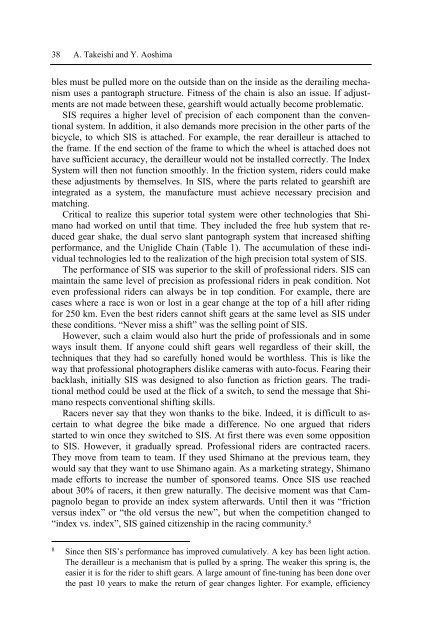Management of Technology and Innovation in Japan
Management of Technology and Innovation in Japan
Management of Technology and Innovation in Japan
Create successful ePaper yourself
Turn your PDF publications into a flip-book with our unique Google optimized e-Paper software.
38 A. Takeishi <strong>and</strong> Y. Aoshima<br />
bles must be pulled more on the outside than on the <strong>in</strong>side as the derail<strong>in</strong>g mechanism<br />
uses a pantograph structure. Fitness <strong>of</strong> the cha<strong>in</strong> is also an issue. If adjustments<br />
are not made between these, gearshift would actually become problematic.<br />
SIS requires a higher level <strong>of</strong> precision <strong>of</strong> each component than the conventional<br />
system. In addition, it also dem<strong>and</strong>s more precision <strong>in</strong> the other parts <strong>of</strong> the<br />
bicycle, to which SIS is attached. For example, the rear derailleur is attached to<br />
the frame. If the end section <strong>of</strong> the frame to which the wheel is attached does not<br />
have sufficient accuracy, the derailleur would not be <strong>in</strong>stalled correctly. The Index<br />
System will then not function smoothly. In the friction system, riders could make<br />
these adjustments by themselves. In SIS, where the parts related to gearshift are<br />
<strong>in</strong>tegrated as a system, the manufacture must achieve necessary precision <strong>and</strong><br />
match<strong>in</strong>g.<br />
Critical to realize this superior total system were other technologies that Shimano<br />
had worked on until that time. They <strong>in</strong>cluded the free hub system that reduced<br />
gear shake, the dual servo slant pantograph system that <strong>in</strong>creased shift<strong>in</strong>g<br />
performance, <strong>and</strong> the Uniglide Cha<strong>in</strong> (Table 1). The accumulation <strong>of</strong> these <strong>in</strong>dividual<br />
technologies led to the realization <strong>of</strong> the high precision total system <strong>of</strong> SIS.<br />
The performance <strong>of</strong> SIS was superior to the skill <strong>of</strong> pr<strong>of</strong>essional riders. SIS can<br />
ma<strong>in</strong>ta<strong>in</strong> the same level <strong>of</strong> precision as pr<strong>of</strong>essional riders <strong>in</strong> peak condition. Not<br />
even pr<strong>of</strong>essional riders can always be <strong>in</strong> top condition. For example, there are<br />
cases where a race is won or lost <strong>in</strong> a gear change at the top <strong>of</strong> a hill after rid<strong>in</strong>g<br />
for 250 km. Even the best riders cannot shift gears at the same level as SIS under<br />
these conditions. “Never miss a shift” was the sell<strong>in</strong>g po<strong>in</strong>t <strong>of</strong> SIS.<br />
However, such a claim would also hurt the pride <strong>of</strong> pr<strong>of</strong>essionals <strong>and</strong> <strong>in</strong> some<br />
ways <strong>in</strong>sult them. If anyone could shift gears well regardless <strong>of</strong> their skill, the<br />
techniques that they had so carefully honed would be worthless. This is like the<br />
way that pr<strong>of</strong>essional photographers dislike cameras with auto-focus. Fear<strong>in</strong>g their<br />
backlash, <strong>in</strong>itially SIS was designed to also function as friction gears. The traditional<br />
method could be used at the flick <strong>of</strong> a switch, to send the message that Shimano<br />
respects conventional shift<strong>in</strong>g skills.<br />
Racers never say that they won thanks to the bike. Indeed, it is difficult to ascerta<strong>in</strong><br />
to what degree the bike made a difference. No one argued that riders<br />
started to w<strong>in</strong> once they switched to SIS. At first there was even some opposition<br />
to SIS. However, it gradually spread. Pr<strong>of</strong>essional riders are contracted racers.<br />
They move from team to team. If they used Shimano at the previous team, they<br />
would say that they want to use Shimano aga<strong>in</strong>. As a market<strong>in</strong>g strategy, Shimano<br />
made efforts to <strong>in</strong>crease the number <strong>of</strong> sponsored teams. Once SIS use reached<br />
about 30% <strong>of</strong> racers, it then grew naturally. The decisive moment was that Campagnolo<br />
began to provide an <strong>in</strong>dex system afterwards. Until then it was “friction<br />
versus <strong>in</strong>dex” or “the old versus the new”, but when the competition changed to<br />
“<strong>in</strong>dex vs. <strong>in</strong>dex”, SIS ga<strong>in</strong>ed citizenship <strong>in</strong> the rac<strong>in</strong>g community. 8<br />
8 S<strong>in</strong>ce then SIS’s performance has improved cumulatively. A key has been light action.<br />
The derailleur is a mechanism that is pulled by a spr<strong>in</strong>g. The weaker this spr<strong>in</strong>g is, the<br />
easier it is for the rider to shift gears. A large amount <strong>of</strong> f<strong>in</strong>e-tun<strong>in</strong>g has been done over<br />
the past 10 years to make the return <strong>of</strong> gear changes lighter. For example, efficiency


